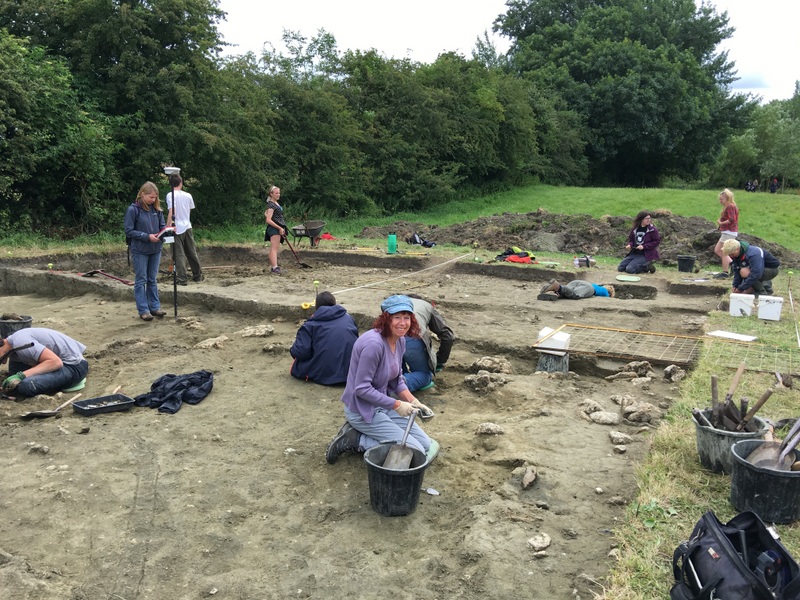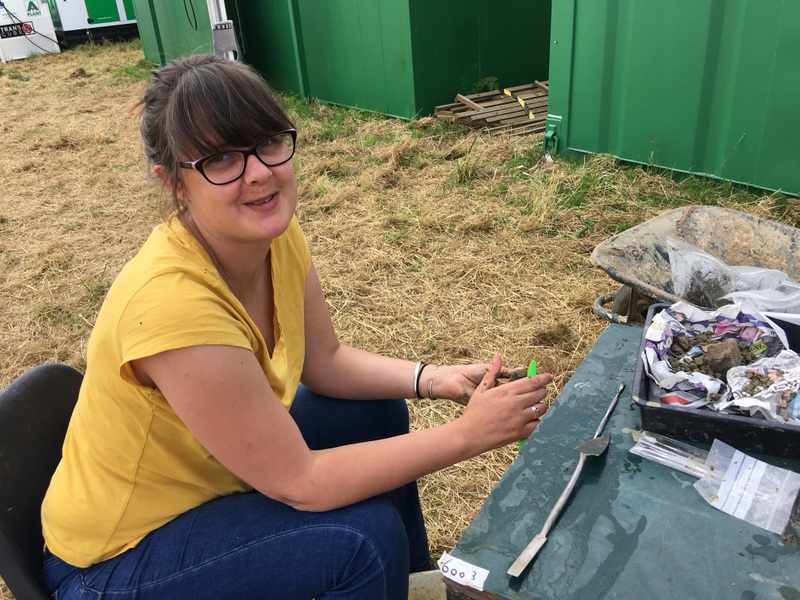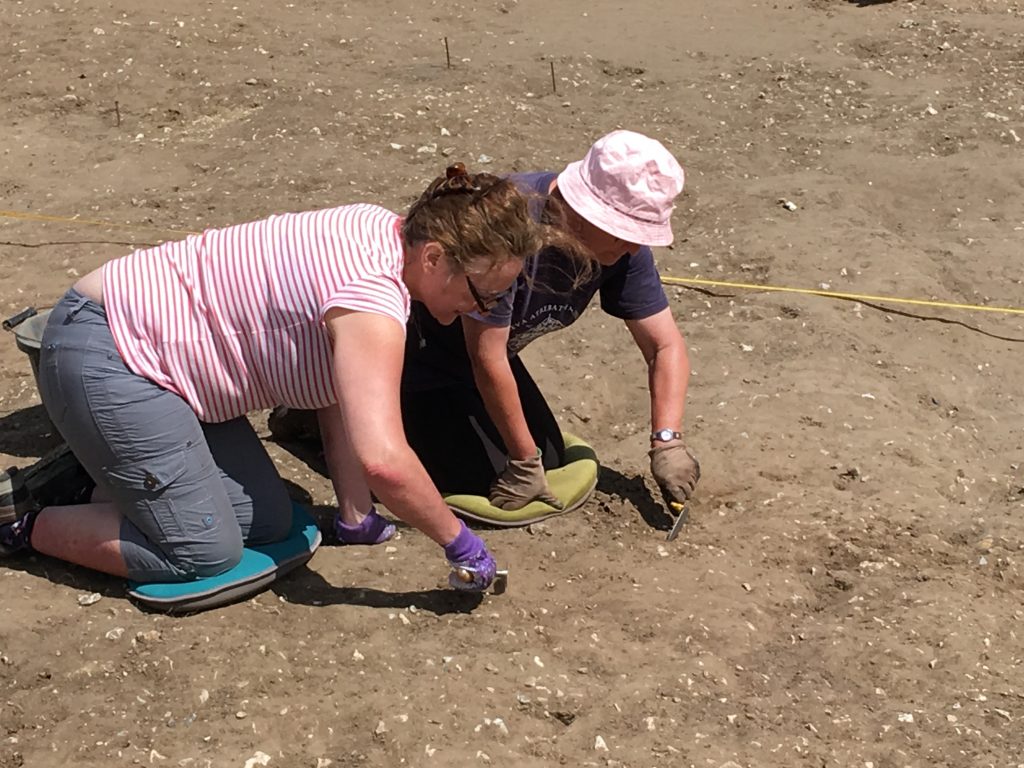What a fast flowing season this is – barely time to catch breath at the end of the day. So my plan to provide a snapview of each day – at the end of each day – has failed! As Dig Directors we carry with us a responsibility that lasts beyond the 5.15pm coach back to the campsite, beyond the marquee supper (where I make a daily litany of announcements which usually involve lifts, whose turn it is to clean the shower and numbers for dinner), and back to my accommodation where I face the day’s haul of emails before falling in to bed, ready for my 6am alarm the next day….it’s a Dig (Dog’s) Director’s life….
So…we are now half away through, and here is a round-up of the headlines for an amalgamated Week 3!
Felicia’s new trench
This trench is placed over a denuded and eroded piece of the henge bank (long removed by a post medieval trackway), and runs down the outside of the bank and over the geophysical anomalies identified by Rob Fry during his Ground Penetrating Radar survey of this area in Week 1. It is a long trench – more than 20m in length – but perfect for the numbers we have and, as became apparent as Mark machine-stripped it, full of easily trowel-able greensand deposits. Now all we have to do is dig it!
New Arrivals
One of the best things about the start of each new week, is the chance to welcome new people to the Field School. I am always passionate about the experience of an excavation, and I know how much my first dig changed my life: the people I met on that first dig are still my friends now. So I relish the opportunity to introduce newcomers to the digging life! I also know that it can take a while to really settle into the flow of an excavation – getting all the right aspects to come together on that very first day is unlikely…..the ideal digging day = the right weather (not too hot, nor too wet or cold) + the right clothes (comfortable yet stylish of course!) + a good night’s sleep (all the better to appreciate the nuances of the soil and the sting of that first blister!) + some understanding of the daft things you are asked to do (e.g. ‘clean’ dirt, ‘get your eye in’, and ‘clear up your loose’). But come together they will. And then you won’t want to leave….
And – as proof that Digging is Fun – we welcome back each year a number of Silchester Stalwarts who have been digging with me at the Field School since time immemorial, and definitely well before the Roman Conquest.
And it is also good to welcome Stella back for her second season at the Archaeology Field School.
Art & Archaeology: a new (ad) venture!
This summer we have organised a collaboration between the Department of Fine Art and the Department of Archaeology at the University of Reading, to take place at the Field School for 1 week, with Wendy Mclean, a Teaching Fellow in the Art department. 8 Art students have been invited to work with us – spending the mornings on site, and then in the afternoons creating artworks in response to their experience of the excavation, the landscape and their overall exposure to field archaeology . The plan is to develop on site collaborations between the Art and Archaeology students, and we hope that both groups will develop and deliver short teaching workshops to each other during their stay. The aim is to encourage and enhance dialogues about our heritage and the ways in which we all experience it. Art and Archaeology have a great deal to share with one another, a great deal to learn from one another – and a great deal of overlap in how we observe, record and represent our heritage and environment.Wendy and I also hope that the residency will provide new areas of research and collaboration between the 2 departments, building on themes of place and identity. The project will also engage with the general public by creating showpieces and conducting workshops which can be enjoyed by visitors to the excavation, Devizes Museum, and the University of Reading. It is planned that the outputs of this collaborative project will also allow the general public to explore their attitudes to, and their experience of, their own heritage.
So, I was very excited when Wendy and the Art students arrived – and brought with them a tonne of enthusiasm which washed over us all! New ideas, new ways of doing things, new ways of looking at things – it was an enormously exhilarating, stimulating and fun-filled week.
Identifying and excavating a Neolithic pit within greensand can be challenging for even experienced archaeologists. Recognising such features is all about colour and texture differences of the soil, combined with the fact that areas which have been disturbed (in this case dug into) consist of looser soils and deposits. It is easy to see why Art students, who work with visual and visceral mediums would make good field archaeologists!

A perfect opportunity for the artist in all of us: just look at the colours revealed in the sides of Felicia’s Trench I! And the chalky green of the rising water…

Colour washes for the artists = Munsell soil books for the archaeologists; creation and identification
Employability
The Archaeology Field School module is all about employability of our students. So many skills are developed at an excavation, and the Field School aims to capture and enhance them all. Throughout the 20 years of the Field School we have built up an exceptionally good relationship with Oxford Archaeology, one of our closest commercial units. A large percentage of OA employees are graduates of the University of Reading – and many are also Field School graduates. OA – and in particular Ben Ford a Senior Project Manager (and ex-Reading graduate and one-time Silchester Field School Supervisor) – appreciate the high level of training the Field School graduates have been given, and many of our students end up in employment with them. It is now something of a tradition: Ben Ford visits us and gives a talk about Oxford Archaeology – and he then leaves with a shuffle of names and CV’s. Depending on the availability of work at the time, a number of our 3rd year Trainees subsequently receive job offers. As a symbiotic relationship it works very well!

And Georgia came too! One time UoR student and Archaeology Field School Trainee, Georgia now works for OA. Here she is with Ben Ford – and a circle of potential employees
Geophysics
Rob Fry returned to us from more exotic locations, for another week of Ground Penetrating Radar (GPR) across the henge bank. He was not short of volunteers to help him!
Visit by Head of the School of Archaeology, Geography and Environmental Sciences (SAGES)
The Field School has many visitors, and this week we played host to Dr. Nick Branch, the Head of SAGES. Being able to show off a smoothly running Field School with happy students, engaged participants, organised trenches and interesting archaeology is always a bonus! We believe that Nick enjoyed his visit!
Work at Wilsford henge
This week saw great progress at the Wilsford henge pits. With Hannah leading a team of 8 – in heroic temperatures with no shade – great results were achieved. I was constantly impressed by the professionalism of this changing team, their dedication to the work in hand and their ability to outstrip the weather and the hard-as-nails soil – and to achieve results!

Deep in Thought – archaeologists thinking. (Left to right) Hannah, Georgia, Ben Ford and Director Jim
Cattle footprints
Oh and this is a wonderful, evocative discovery (the Art students loved this!) – a spread of ancient cattle hoofprints….trodden down into the layers of medieval peat visible in the sides of Felicia’s Trench I. Martin excavated them in plan – and just imagine all those little hooves trampling and jostling and pushing the muddy peat back down through the time sequence, back into time.
Open Day
We had a fantastically successful Open Day: the sun shone and the promised ‘hordes’ arrived! 405 people,and our carpark was full to overflowing. There was never a quiet moment from beginning to end. All kinds of things on offer, and a wonderfully engaged, good humoured and interested crowd! It was exactly what Director Jim and I had hoped for.

And this is how we ‘do’ Science at the Field School: (left to right) Luke, Luciano, Samira (Senior Trainee), Elsie (Science Manager), Sarah and Eliz (Trainee)
Saturday party
Every weekend we are joined by various Field School graduates; the Silchester Field School offered the consummate field experience for so many people and they love to return (all grown up) to share their stories and encourage the current crop of 1st year students. And the theme of this saturday night party? Noah’s Ark…..

Field School successes! Left to right: Rory (Silchester Field School technician); Verity (working in commercial field archaeology and applying for a Masters’ degree); Josh (working in commercial archaeology); Hannah (working in commercial archaeology); Zoe (working in commercial archaeology)
Young Archaeologists win prizes!
This year the Archaeology Field School hosted the 3 winners of the national Young Archaeologists’ Club competition: Tom,Thomas and Hugh. They had to answer the question: Name the 4 Super henges (and, as I am sure you all know, they are….Marden, Mount Pleasant. Avebury and Durrington Walls…). Tom, Thomas and Hugh (and their appropriate parent!) spent a day with us on site, alongside our students and mentored by Katherine, Adam, Henry and Harry. They looked at our finds with Trainee Dannielle, and were able to handle some of the beautiful flintwork we have discovered.
They also spent some time in the Science Hut, and were given a tour of the archaeology, going around each trench in turn. But I am fairly sure that the highlight of their day was being able to do some digging in Edoardo’s trench…..and, guess what…they found some nice pieces of struck flint. Clearly they are all archaeologists in the making!
It was a very successful day – for everyone involved. And Hugh’s mother did a beautiful coloured sketch of the Young Archaeologists hard at work in Edoardo’s trench.
Changeover day
Week 3 draws to a close……over 30 people leaving…and over 20 arriving!






























































































































